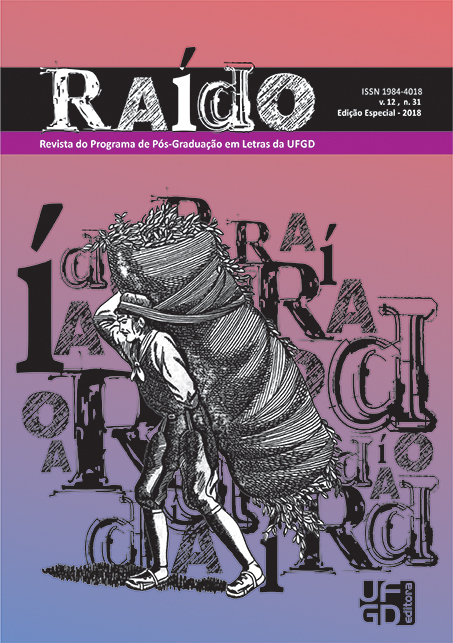Que entrem as bailarinas – uma análise multimodal baseada na teoria ator-rede
DOI:
https://doi.org/10.30612/raido.v12i31.8128Palavras-chave:
Teoria Ator-Rede (TAR). Construção identitária. Eu. Multimodalidade.Resumo
O objetivo desse artigo é investigar como os elementos físicos e não físicos no vídeo de Zach Gross contribuem para representar a principal personagem feminina, Tatyana, em torno da qual se desenvolve o enredo. O vídeo apresenta duas bailarinas no Metropolitan Opera House executando uma cena de Onegin, uma ópera de Tchaikovsky, baseada na obra clássica de Pushkin, a qual leva o mesmo nome O estudo é teórica e metodologicamente apoiado na teoria ator-rede (TAR) e no modelo multimodal definido em Banks (2015). O ponto principal foi mostrar como o entrelaçamento de objetos humanos e não humanos na construção de rede, incluindo o próprio corpo, ocorre através de espaços físicos e virtuais na expressão do eu.
Downloads
Referências
ACOCELLA, J. Bring in the Ballerinas. Accessible at https://www.newyorker.com/magazine/2012/06/25/bring-in-the-ballerinas, retrieved in Nov. 2017.
BAHKTIN, M. Estética da Criação Verbal. São Paulo: Martins Fontes, 1997.
BANKS, J. Multimodal, multiplex, multispatial: A network model of the self. New Media & Psychology, v. 19 n. 3, p.1-20, October 2015.
CASTELLS, M. O Poder da Identidade. São Paulo: Ed. Paz e Terra S/A, 2008.
GERGEN, K.J. Social Construction and the Transformation of Identity Politics. Available at https://www.swarthmore.edu/sites/default/files/assets/documents/ Retrieved on 08 May 2017.
GERGEN, K.J.Social%20Construction_and_the_Transformation.pdf, 1999, Acesso em 08 May 2017.
GERGEN, K.J. The Saturated Self: Dilemmas of Identity in Contemporary Life. USA: Basic Books, 2000.
GIDDENS, A Modernity and Self-Identity: Self and Society in the Late Modern Age. Stanford, Ca.: Stanford University Press, 1991.
GROSS, Z. Bring in the Ballerinas (video). Accessible at https://thescene.com/watch/thenewyorker/bring-in-the-ballerinas, . Retrieved in Nov. 2017.
GUBRIUM, J.F.; HOLSTEIN J.A. Grounding the postmodern self. The Sociological Quarterly 35(4): p. 385–703, 1994.
HAESBAERT, R. Fim dos terrritórios ou novas territorialidades? IN: MOITA LOPES, L.P; BASTOS, L C (orgs.) Identidades: Recortes Multi e Interdiscipinares. São Paulo: Mercado das Letras, 2002.
KISSELGOFF, A. Dance Review: An American Flourish to Stuttgart’s Signature. Available at http://www.nytimes.com/2001/06/04/arts/dance-review-an-american-flourish-to-stuttgart-s-signature.html Retrieved on 7 December 2017.
LATOUR B. Reassembling the Social: An Introduction to Actor-Network Theory. New York: Oxford University Press, 2005.
LEARY, M.R. Motivational and Emotional Aspects of the Self. Annual Review of Psychology n.58, p. 317-344, March, 2007.
LEMOS, A. Espaço, mídia locativa e teoria ator-rede. Galáxia, n.25, p.52-65, June 2013.
LÉVI-STRAUSS, C. The Savage Mind. Chicago, IL.: University of Chicago Press, 1966.
LYOTARD, J-F. The Postmodern Condition: A Report on Knowledge (trans. G Bennington and B Massumi). Minneapolis, MN: University of Minnesota Press, 1984.
LӦW, M. The Constitution of Space – The Structuration of Spaces Through the Simultaneity of Effect and Perception. European Journal of Social Theory 11(1), p.25-49. August, 2008.
MEAD, G.H. Mind, Self, and Society. Chicago, IL: University Of Chicago Press, 1934.
OYSERMAN, D.; ELMORE, K.; SMITH, G. Self, Self-Concept and Identity. In: Leary MR and Tangney JP (eds) Handbook of Self and Identity. New York: Guilford Press, p. 3–14, 2012.
PAPACHARISSI, Z. Conclusion: A networked self. In Papacharissi, Z. (ed.) A Networked Self: Identity, Community, and Culture on Social Network Sites. New York, NY: Routledge, p. 304–318, 2011.
PESSOA, F. 35 Sonnets IN: De Sena, J.; MONTEIRO, A.C.; De PORTUGAL, J.B. Poemas Ingleses. Lisboa. Atica, 1974.
RIBEIRO, J.C. The increase of the experiences of the self through the practice of multiple virtual identities. PsychNology Journal, v.7 n.3, p.291–302, 2009.
TURKLE, S. Life on the Screen: Identity in the Age of the Internet. New York:Simon & Schuster, 1995.
TVERITINA, A.The Metropolitan Opera spreads Pushkin and Tchaikovsky around the World. Available at https://www.rbth.com/literature/2013/09/21/ the_metropolitan_opera_spreads_pushkin_and_tchaikovsky_around_the_world_30021.html. Retrieved on 7 December 2017.
WIKIVERSITY. Eugene Onegin. Accessible at: https://en.wikiversity.org/w/index.php?title=Eugene_Onegin&oldid=1125138. Retrieved on 4 Dec 2017
Downloads
Publicado
Como Citar
Edição
Seção
Licença
Os autores devem aceitar as normas de publicação ao submeterem a revista, bem como, concordam com os seguintes termos:
(a) O Conselho Editorial se reserva ao direito de efetuar, nos originais, alterações da Língua portuguesa para se manter o padrão culto da língua, respeitando, porém, o estilo dos autores.
(b) Autores mantém os direitos autorais e concedem à revista o direito de primeira publicação, com o trabalho simultaneamente licenciado sob a Atribuição-NãoComercial-CompartilhaIgual 3.0 Brasil (CC BY-NC-SA 3.0 BR) que permite: Compartilhar — copiar e redistribuir o material em qualquer suporte ou formato e Adaptar — remixar, transformar, e criar a partir do material. A CC BY-NC-SA 3.0 BR considera os termos seguintes:
- Atribuição — Você deve dar o crédito apropriado, prover um link para a licença e indicar se mudanças foram feitas. Você deve fazê-lo em qualquer circunstância razoável, mas de nenhuma maneira que sugira que o licenciante apoia você ou o seu uso.
- NãoComercial — Você não pode usar o material para fins comerciais.
- CompartilhaIgual — Se você remixar, transformar, ou criar a partir do material, tem de distribuir as suas contribuições sob a mesma licença que o original.
- Sem restrições adicionais — Você não pode aplicar termos jurídicos ou medidas de caráter tecnológico que restrinjam legalmente outros de fazerem algo que a licença permita.



